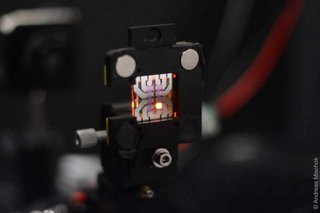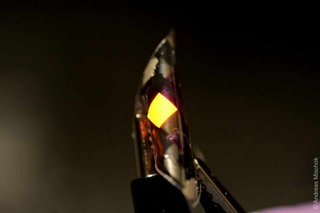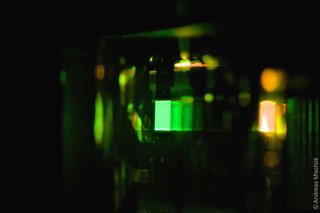A research team from the University of Cologne (Germany) and the University of St Andrews (Scotland) has shown in a new study how a fundamental physical concept can be used to boost the colour brilliance of smartphone, computer or TV screens without cutbacks in energy efficiency. The results have been published in Nature Photonics.
Organic light-emitting diodes (OLEDs) have conquered the market for displays in recent years – from high-resolution smartphone to wall-sized television screens. However, industry and science face several challenges in creating the next generation of devices with even higher colour saturation, brightness and efficiency. The organic molecules from which OLEDs are made have intrinsically broad emission spectra – a property that limits the available colour space and saturation for high-end displays. Colour filters or optical resonators can be used to artificially narrow the emission spectra of OLEDs to circumvent this issue. However, this either comes at the expense of efficiency or leads to a strong dependence of the perceived colour on the viewing angle.
Researchers at the two universities have now shown that a fundamental scientific principle – the strong coupling of light and matter – can be used to change the emission spectra of OLEDs while avoiding the change of colour at oblique viewing angles. When photons (light) and excitons (matter) exhibit sufficiently large interaction with each other, they can strongly couple, creating so-called exciton polaritons. The principle can be compared to energy transferred between two coupled pendulums, except here it is both light and matter that are coupling with each other and continuously exchanging energy. These polaritons eventually emit light again. By embedding the entire layer stack of the OLED between thin mirrors made of metallic materials, which are already widely used in the display industry, the coupling between light and organic material can be significantly improved. Until now, however, strong coupling in OLEDs has inevitably led to low electrical efficiency. To avoid this, the researchers added a separate thin film of strongly light-absorbing molecules similar to those already used in organic solar cells, but not in OLEDs. The additional layer maximized the effect of strong coupling, but without significantly reducing the efficiency of the light-emitting molecules in the OLED.
“By generating polaritons, we can transfer some of the advantageous properties of matter to our OLEDs – including their significantly lower angular dependence, so that the colour impression of a display remains brilliant and stable from any perspective,” said Dr Andreas Mischok, first author of the study.
Although polariton-based OLEDs have been reported on in the past, their energy efficiency and brightness have been low. This has prevented practical applications and kept them mainly confined to basic research. With the new strategy, the team has now successfully realized polariton-based OLEDs at efficiency and brightness levels suitable for practical application for the first time.
Professor Malte Gather, who led the study, believes: “With efficiency and brightness comparable to OLEDs that are used in commercial displays, but with significantly improved colour saturation and colour stability, our polariton-based OLEDs are of great interest to the display industry.”
The on-demand and efficient production of a large number of polaritons is not only relevant for the next generation of displays, but can also be used for a wide range of other applications – from lasers to quantum computing.
Media Contact:
Professor Dr Malte Gather
Humboldt Centre for Nano- and Biophotonics
Chemistry Department, University of Cologne
+49 221 470 76449
malte.gatheruni-koeln.de
Dr. Andreas Mischok
Humboldt Centre for Nano- and Biophotonics
Department Chemie, Universität zu Köln
+49 221 470 76450
andreas.mischokuni-koeln.de
Press and Communications Team:
Jan Voelkel
+49 221 470 2356
j.voelkelverw.uni-koeln.de
Publication:
https://www.nature.com/articles/s41566-023-01164-6
Further Information:
www.gatherlab.uni-koeln.de


